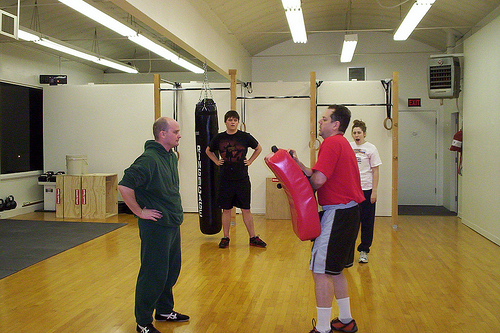


Winter was just getting started the last time we looked at health and fitness programs for people with disabilities. The season has been relatively mild by New England standards, and people are sure to be catching spring fever as temperatures top 60 degrees over the next couple of days. So, with the opportunity to get out of doors upon us, let’s look at a couple of stories about new programs that encourage active, healthy lifestyles for people with disabilities.
A YMCA in Lynchburg, Virginia, is taking measures to ensure fitness training for people with disabilities reaches beyond the weight room and exercise studios. A new eight-week program, entitled “Fitness and Well-being for Individuals with Special Needs,” combines exercise with nutrition education; it also requires each participant to be accompanied by a family member or caregiver to ensure that good habits carry over into everyday lives.
Amy Trent’s report about the program on the WSLS website features this slideshow that shows smiling participants playing Twister and making fruit smoothies while audio clips from the YMCA staff and caregivers relate the value of stretching before exercising and extol the virtues of the buddy system. Megan Garland puts it best when she explains how the approach has been effective:
They see exercise and they shudder. They don’t want to do it. They don’t want to get on the treadmill. But all of a sudden you add this social aspect to it and it’s fun; it’s more like a game.
Garland is the caregiver for Nathan Overstreet, and she also says the program has helped Nathan be more mentally engaged and given him a certain sense of freedom. Similar outcomes are being produced in upstate New York, where instructors in a martial arts dojo are offering a self-defense class for people with disabilities. Kathleen Poliquin’s article on “Cane-Fu” in the Post-Standard was replicated for the Syracuse.com blog, and in it one of the instructors shares a letter from a neurosurgeon, who says of the training:
Practicing the moves as taught will help with rehabilitation and mobility. But most importantly, the very act of learning self-defense after neurologic loss can provide a patient an improved outlook.
Instructor Eric Stalloch says the key is getting people to look at their cane as a piece of adaptive equipment, used for exercise and mobility versus a sign of vulnerability. This video by Post-Standard photographer Frank Ordonez accompanies the article, demonstrating techniques for people who use canes or are in wheelchairs to break away from assailants.
Comments?
Image by Rosey-OR, used under its Creative Commons license.